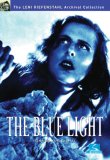| Reviews & Columns |
|
Reviews DVD TV on DVD Blu-ray 4K UHD International DVDs In Theaters Reviews by Studio Video Games Features Collector Series DVDs Easter Egg Database Interviews DVD Talk Radio Feature Articles Columns Anime Talk DVD Savant Horror DVDs The M.O.D. Squad Art House HD Talk Silent DVD
|
DVD Talk Forum |
|
|
| Resources |
|
DVD Price Search Customer Service #'s RCE Info Links |
|
Columns
|
|
|
Blue Light, The
Where Americans have the western, the Germans have bergfilme. This genre of film centers around mountain climbing and the hazards associated with the activity, and is almost solely German in nature. It was very popular in Germany between the wars and launched many careers including Dr. Arnold Fanck who is the director most associated with the genre, and Leni Riefenstahl the one time dancer who became a leading lady and then world famous director.
After appearing in several Fanck pictures, Riefenstahl started directing her own bergfilmes with The Blue Light a move that she also stars in and wrote. It was this film that entranced Adolph Hitler brought the director to his attention. Meeting with the leader of the Nazi party, Riefenstahl agreed to make an hour long documentary about the Nazis which was released as Der Sieg des Glaubens (Victory of Faith). The following year she filmed the 1934 Nazi Party rally at Nuremberg. The film to come out of this rally, Triumph of the Will, is one of the most effective propaganda movies ever set down on film and greatly advanced the Nazi cause. As impressive as that film is, you can see Riefenstahl's eye for style and scenery in this first film that she directed.
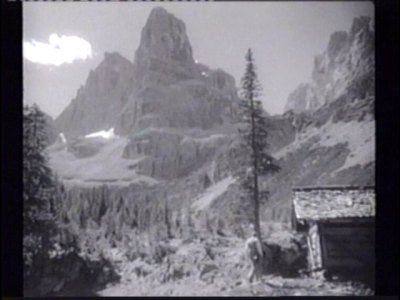
In a small mountain town in Germany, the villagers know that there are valuable gems at the top of the local peak. Every full moon the top of the mountain gives off a blue light that signals the crystals are there for the taking. Many of the young man of the village try to climb the peak, and some do bring back small pieces of the gemstone, but none of them are able to make it to the top. Many die in the attempt, lured by the promise of untold riches.
There is one person who can make it to the top however, a young girl that has been ostracized from the community, Junta (Riefenstahl). She's called a witch and lives alone in the wild, only coming to town occasionally. On one trip into town, a merchant sees that Junta's carrying a huge crystal from the mountain. She refuses to sell her treasure to him and runs away, but this event brings her to the attention of Vigo (Mathias Wieman). The young man in attracted to the wild, free girl who lives on the mountain and seeks her out and eventually gains her trust. She shows him the path she uses to get to the treasure, which leads to the film's tragic ending.
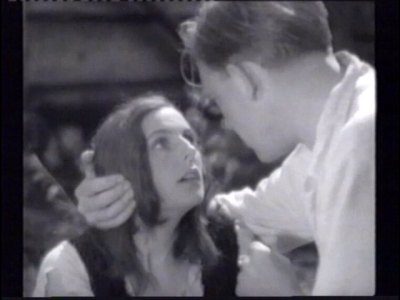
This was a good bergfilme. While it doesn't have as much mountain climbing scenes as some others in the genre, the story was interesting and there was a good amount of drama. The main attraction of this film however was the glorious cinematography. Riefenstahl was able to make the mountains impressive and foreboding yet beautiful. She turns Junta's simple home into a Eden-like setting with abundant berries for her to eat and picturesque waterfalls right outside her door.
The message of the film is also clear and strong without being overpowering. While Vigo is an intellectual and a member of modern society, he has little in common with the simple Junta. While the girl has almost nothing and is content with it, Vigo is constantly striving to get more and more. The barrier between nature and civilization is clear, but the two manage to get over that wall and fall in love. That turns out not to be enough, and in the end it is clear that Vigo never did understand the woman he loved.
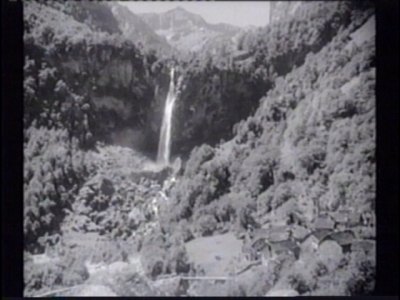
A very impressive early sound movie, it was obviously film silently and then an audio track was added on in post-production. The dialog is fairly sparse, as are the sound effects. This movie was also released as a silent film in the US, though it was heavily edited.
The silent version of the movie doesn't play nearly as well as the sound version, but the dialog and sound effects have little to do with that. The silent edit was cut by about 27 minutes, over a third of the movie, and this really hurts the flow of the narrative, to say the least. This version of the movie is pretty bad and should only be viewed to see just how badly a film can be mutilated.
The DVD:
Both the sound German version of this film and the silent edit made for export to non-German speaking countries is included on this single sided DVD. It comes in a standard keepcase. There is no insert.
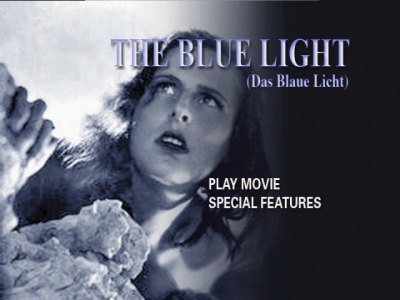
Audio:
The sound version of this film comes with the original German soundtrack in two channel mono. The quality was fine for an early sound film. Of course there was little in the way of dynamic range, but the sound was clean with no hum or hiss, and the dialog was strong.
The silent version, on the other hand, sounded pretty bad. It was presented with an old mono score that consisted mainly of guitar music and was not scene specific. There was a very loud hum through the entire film too. Not very impressive.
Video:
The video was windowboxed, with an aspect ratio of 1.18:1. The image was very soft, and a little bright, but otherwise it looked very nice. Though fine details were blurry the overall picture was clear and there was a good amount of contrast.
The silent version, by contrast, looked pretty poor. The image was faded, scratchy and dull with little in the way of contrast. A pretty poor presentation all together.
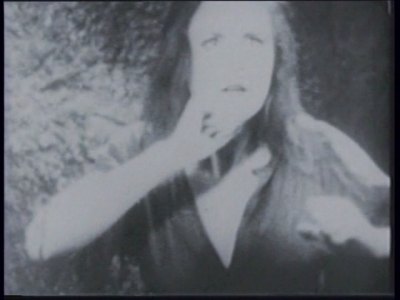 |
| |
Extras:
This disc also comes with an image gallery that collects 18 publicity and production photos from the film. A nice collection.
Final Thoughts:
This first movie that Leni Riefenstahl directed is a good film and clearly shows the potential that she would nurture. The scenery is beautiful and the story has a lot of drama. The audio and video quality of the original version is good, but the silent film leaves a bit to be desired in both categories. I'd look at the silent edit as a bonus feature rather than a film onto itself. (I've graded the film that way.) This was an interesting film that is easy to recommend.
|
| Popular Reviews |
| Sponsored Links |
|
|
| Sponsored Links |
|
|
| Release List | Reviews | Shop | Newsletter | Forum | DVD Giveaways | Blu-Ray | Advertise |
|
Copyright 2024 DVDTalk.com All Rights Reserved. Legal Info, Privacy Policy, Terms of Use,
Manage Preferences,
Your Privacy Choices | |||||||









